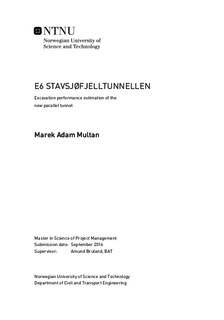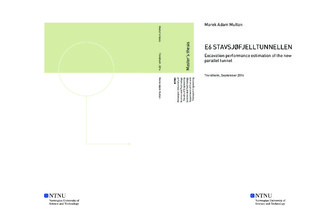| dc.description.abstract | This Master Thesis, written in 2016, is a result of the cooperation between NTNU and Reinertsen AF. The aim of the Thesis is to estimate the performance of the excavation of the second tube of Stavsjøfjelltunnelen. The tunnel is located between Trondheim and Værnes, and is an important connection between Trondheim and the airport. The planned construction is the result of increasing traffic and is the way to meet the demands of new safety regulations. The existing tunnel is 1730m long, including portals, from which 1700m is the excavated tunnel. According to the available information the new Tunnel is around 1720m long. Due to the changing geological conditions, close residential areas as well as existing parallel tunnel located close to the planned tunnel, the vibration restrictions were expected to become the most important factor influencing the excavation performance. The vibration limits have to be set, due to the existing requirements, in order to prevent unexpected fall downs in the existing tunnel, as well as to ensure safe blasting around the residential area sections. The estimation of the vibration level caused by the blast has been established based on four widely used methods, from which one has been selected. The vibration restrictions influence the Drill and Blast design that was suggested in this Thesis. The analysis of the excavation performance using a prototype of Tunnel Excavation Performance (TEP) Model shows that the tunnel could be finished between 368 and 393 days depending on the rock condition. The time windows that the blasts are allowed to be undertaken, that are the result of the existing traffic in the parallel existing tunnel, have been found to have influence on total time. By removing the time constrains the tunnel excavation would be reduced to 323 days. By allowing constant work 24 hours 5 days a week the total duration of the project would be reduced to 312 days. Not taking the injection into consideration that would delay the project by 7 weeks in case of Stavsjøfjelltunnelen. Therefore it is highly recommended to evaluate if the existing tunnel could be closed for the duration of the construction period and if the work could be performed 24 hour 5 days a week. | |

